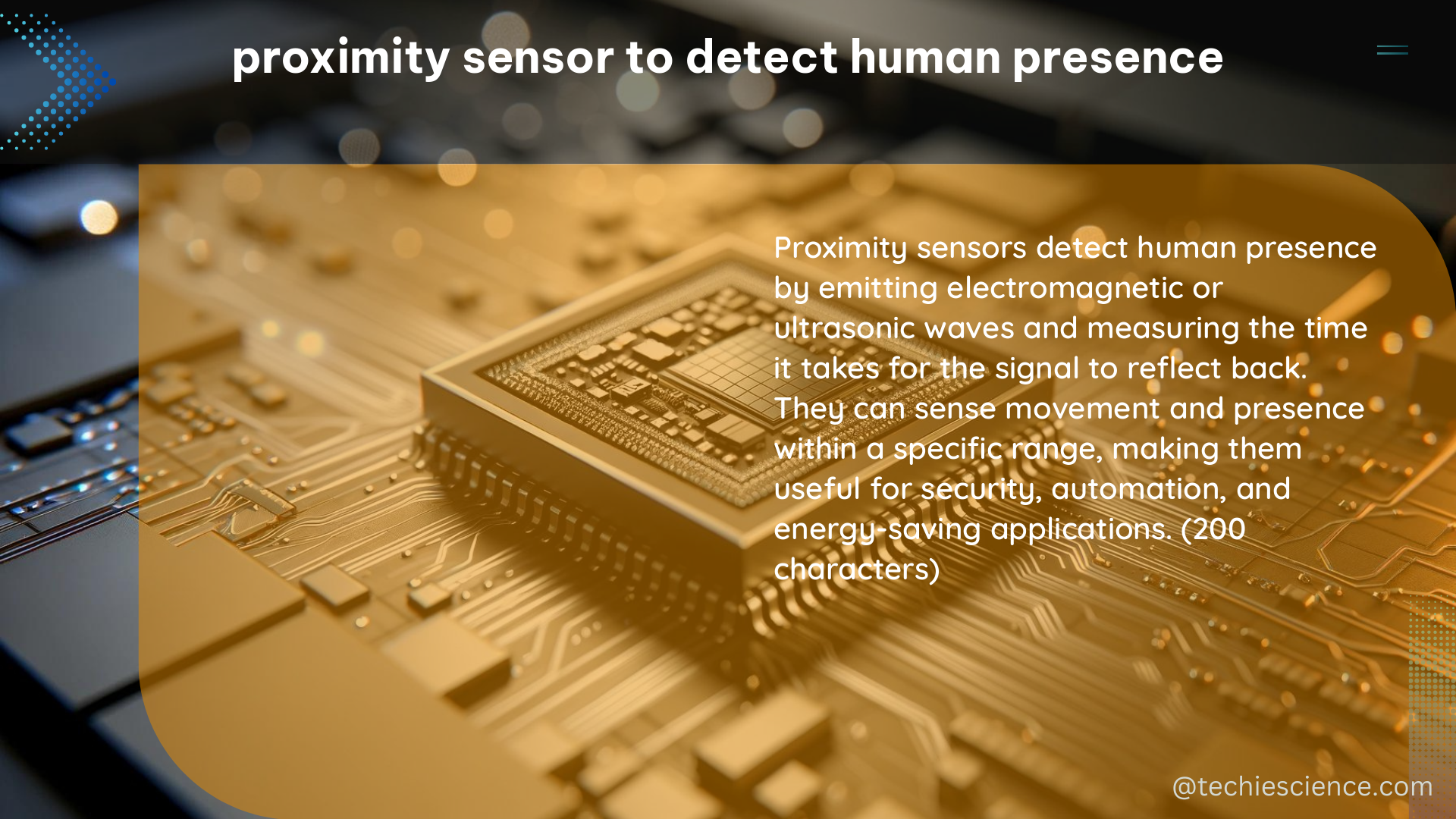Proximity sensors are versatile electronic devices that can detect the presence of nearby objects without any physical contact. These sensors are widely used in various applications, including human presence detection, which is crucial for security, automation, and energy-saving systems. In this comprehensive guide, we will explore the measurable and quantifiable data associated with proximity sensors for human presence detection, their technical specifications, and a step-by-step guide to building a DIY proximity sensor.
Measurable and Quantifiable Data on Proximity Sensors for Human Presence Detection
- Detection Range:
- Infrared (IR) proximity sensors can detect objects from a few centimeters to several meters, with typical detection ranges of 10-80 cm.
- Ultrasonic proximity sensors can detect objects up to 4-5 meters away, with a common range of 2-400 cm.
- Capacitive proximity sensors can detect objects from a few millimeters to several centimeters, typically within a 0-10 mm range.
-
Time-of-flight sensors can detect objects up to several meters away with high accuracy, often in the range of 4-100 cm.
-
Field of View:
- IR proximity sensors typically have a field of view of 5-10 degrees.
- Ultrasonic proximity sensors have a field of view of about 15-30 degrees.
- Capacitive proximity sensors have a wider field of view, ranging from 30 to 150 degrees.
-
Time-of-flight sensors have a field of view of about 70-90 degrees.
-
Sensing Technology:
- IR proximity sensors use infrared light to detect the presence of objects.
- Ultrasonic proximity sensors use sound waves to detect the presence of objects.
- Capacitive proximity sensors use changes in capacitance to detect the presence of objects.
-
Time-of-flight sensors use time-of-flight measurements to detect the presence of objects.
-
Power Consumption:
- IR proximity sensors typically consume less power than ultrasonic proximity sensors.
- Capacitive proximity sensors consume more power than IR proximity sensors but less power than ultrasonic proximity sensors.
-
Time-of-flight sensors consume more power than other proximity sensors due to their high accuracy and long detection range.
-
Response Time:
- IR proximity sensors have a response time of a few milliseconds.
- Ultrasonic proximity sensors have a response time of about 10-100 milliseconds.
- Capacitive proximity sensors have a response time of about 1-10 milliseconds.
- Time-of-flight sensors have a response time of about 1-10 milliseconds.
Technical Specifications of Proximity Sensors for Human Presence Detection

Here are the technical specifications of some commonly used proximity sensors for human presence detection:
| Sensor | Detection Range | Field of View | Output | Response Time |
|---|---|---|---|---|
| Sharp GP2Y0A21YK0F Analog Distance Sensor | 10-80 cm | 35 degrees | Analog | 38 ms |
| HC-SR04 Ultrasonic Distance Sensor | 2-400 cm | 15 degrees | Digital | 10-150 ms |
| MLX90393 Capacitive Proximity Sensor | 0-10 mm | 180 degrees | Analog | 1 ms |
| VL53L0X Time-of-Flight Distance Sensor | 4-100 cm | 25 degrees | Digital | 20 ms |
Building a DIY Proximity Sensor to Detect Human Presence
To build a DIY proximity sensor to detect human presence, follow these steps:
-
Choose a Proximity Sensor: Select a proximity sensor that meets your requirements in terms of detection range, field of view, sensing technology, power consumption, and response time. Consider factors such as the intended application, the environment, and the available resources.
-
Connect the Sensor to a Microcontroller: Connect the chosen proximity sensor to a microcontroller, such as an Arduino or Raspberry Pi, using the appropriate pins and wiring. Ensure that the sensor and microcontroller are compatible and can communicate effectively.
-
Write a Program to Read Sensor Data: Develop a program in the microcontroller’s programming language (e.g., C or Python) to read the sensor data and trigger an action when an object is detected. This may involve setting up thresholds, filtering noise, and implementing appropriate logic for your specific application.
-
Test the Sensor: Thoroughly test the proximity sensor by placing objects within its detection range and observing the sensor’s response. Adjust the program or sensor placement as needed to ensure reliable and accurate detection.
-
Integrate the Sensor into a System: Integrate the proximity sensor into a larger system, such as a security system or a home automation system, to detect human presence and trigger appropriate actions, such as turning on lights, activating alarms, or controlling HVAC systems.
By following these steps, you can build a DIY proximity sensor that can effectively detect human presence and integrate it into your desired application.
References
- “Proximity Sensors” by Texas Instruments: https://www.ti.com/sensing/proximity/overview.html
- “Ultrasonic Sensor HC-SR04” by RobotDyn: https://www.robotdyn.com/ultrasonic-sensor-hc-sr04-p-962.html
- “Capacitive Proximity Sensor MLX90393” by Melexis: https://www.melexis.com/en/product/MLX90393/Capacitive-Proximity-Sensor
- “VL53L0X Time-of-Flight Distance Sensor” by STMicroelectronics: https://www.st.com/en/imaging-and-photonics-solutions/vl53l0x.html
- “Arduino Proximity Sensor Tutorial” by ElectroPeak: https://electropeak.com/learn/arduino-proximity-sensor-tutorial/
- “Raspberry Pi Proximity Sensor Tutorial” by Raspberry Pi Foundation: https://www.raspberrypi.org/learning/physical-computing-with-python/proximity-sensor/

The lambdageeks.com Core SME Team is a group of experienced subject matter experts from diverse scientific and technical fields including Physics, Chemistry, Technology,Electronics & Electrical Engineering, Automotive, Mechanical Engineering. Our team collaborates to create high-quality, well-researched articles on a wide range of science and technology topics for the lambdageeks.com website.
All Our Senior SME are having more than 7 Years of experience in the respective fields . They are either Working Industry Professionals or assocaited With different Universities. Refer Our Authors Page to get to know About our Core SMEs.